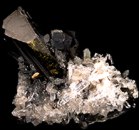|
|
| Formula: | Ca2(AlFe)3(SiO4)3(OH) |  Click to see a larger image |
||
| Crystal: | Monoclinic | |||
| Hardness: | 6-6.5 | |||
| Spec. Gr.: | 3.2-3.5 | |||
| Streak: | Uncolored, grayish | |||
| Cleavage: | Perfect basal | |||
| Location: | Prince of Wales Island, Alaska |
| Epidote forms by the metamorphism of rocks at relatively low temperatures but at high pressures. Epidote crystals are formed in more than 200 forms particularly columnar, lath-like and acicular. It striates longitudinally on crystals which are usually perfectly crystallized. Crystals are dark to black-green and have a distinct cleavage, glassy luster, and gray streak. Epidote is common and is widely distributed. Exceptionally fine epidote crystals have occurred at Knappenwand in the Untersulzbachtal of Austria; on Green Monster and Copper mountains on Prince Of Wales Island, Alaska; and the Achmatovsk mines, Ural Mountains, Russia. The giver of this jewel is supposed to strengthen their astral or planetary influence and to render them more potent charms. |
|
Bibliography: Bancroft, Peter, Gem and Crystal Treasures, pg. 111-115. Kunz, George Frederick, The Curious Lore of Precious Stones, pg. 111-115. |
|
University of California, Santa Barbara—Department of Earth Science Copyright © 2005 Regents of the University of California Send your comments to the Web Page Editor |